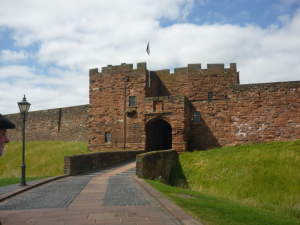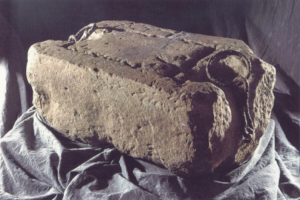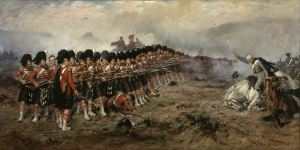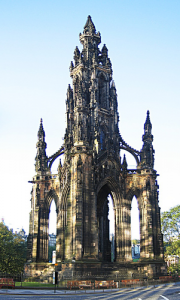PART II: SCOTLAND
Go to Part I: Arriving in England
Go to Part III: Back to England
Friday, July 28: Carlisle to Edinburgh
Waking up in my room I looked out the window and saw probably one of the most beautiful sights of the entire trip: the sun was breaking and hundreds of lambs were lying on the ground. The hills were green and moist with dew. I decided that if I ever win the lottery, I’m going to retire in northern England. It’s that darn pretty. I especially admired the construction of the houses which were mostly stone with wood beams.
Another English breakfast. By now we decided that all that stuff about eggs, bacon, and cholesterol was a bunch of hooey. We bid our farewells, gathered our bags, and took the bus back to Humshaugh to pick up our car. At that point we had a decision to make, how best to get to Edinburgh. We decided that we would go through Carlisle. We got there about noon and as it was a Friday, we had some authentic fish and chips. Quite good actually. Much better than anything I’d have in the States. If I had to guess I’d say that they used a lot of butter in the batter. More ale.
Carlisle Castle
In the past, Carlisle was contested by both England and Scotland. Its main claim to fame is its castle which is probably one of the largest in Britain. Carlisle was a flashpoint in the incessant struggles between England and Scotland and the Scottish influence is definitely apparent once you get inside. As I understand it, the castle is still an active military base and it had several modern barracks within its walls, each one bearing the name of a famous WWI battle (“Gallipoli,” “Verdun,” “Ypres,” etc.) Its military museum is well worth the price of admission. Seeing its dungeons where the Highland supporters of Bonnie Prince Charlie were held was humbling, especially when you realize that many of them were hanged, drawn and quartered. Their tragic end was immortalized in the poem “Loch Lomond,” in which one of the condemned Jacobites says to his beloved right before his death:O ye’ll tak’ the high road, and I’ll take the low/And I’ll be in Scotland afore ye/for me and my true love will ne’er meet again/On the bonnie, bonnie banks o’ Loch Lomon’.
I could not help shedding a tear when Mikey recited this poem as we were driving sometime later. For those who don’t know, the “low road” meant death. You don’t have to be Scottish to appreciate it or the sentiment—the desire to be free—behind it.
Next stop, Scotland!
It was sunny that day and once we cross the River Tweed we perked up considerably. We were making pretty good time and decided that we’d spend two nights in Edinburgh. My godson and good friend, Sam Matthews has been to Scotland several times and runs a Celtic import business. He’s intensely proud of his Scottish heritage and gave me some tips (as did my baby sister Gina, who had gone the year before with her family).
We ate very well at The Beefeater on Willowbrae Road and asked where some B&Bs were located. The waiter gave us some addresses but the roads are confusing as all heck. Not too far away however, we found a B&B called The Drumorne. It had a vacancy but this time all three of us had to share a room. Prices were reasonable, about $45 per person, per night.
Saturday, July 28: Edinburgh
Another British breakfast, this time we were joined by two families from Thessaloniki who were staying at the same B&B. It was good to talk in Greek and compare our notes. I asked the host for directions to a Laundromat and I took our duffel bag full of dirty clothes which the laundress washed and folded. I espied a barbershop across the street and got a much-needed shave. Sam and Gina both told us to go to High Street and so we did.
High Street (also known as The Royal Mile) is well-named as it sits in the middle of Edinburgh and at its highest elevation. At the top is Edinburgh Castle, at the bottom is Holy Rood Palace. We emerged at High Street sort of in the middle, not too far from St Giles’ Cathedral where Zara Phillips (Princess Anne’s daughter) had married some famous Rugby player earlier that day. Flags were everywhere and even though this wasn’t as big a shindig as Will and Kate’s wedding, it was still considered somewhat of a big deal. They were handing out British flags to the thousands of people who were milling about.
It was nice to just play the tourist for awhile and not the exhausted hiker. On the way to the Castle, we stopped at a rather enjoyable tourist trap called The Scotch Experience. There one could learn all you can about the fine art of single-malt Scots whiskey. I was only introduced to single malts fairly recently thanks to Sam (I’m pretty much a Bourbon drinker). We couldn’t believe how many different whiskeys there were. One room had the largest collection of single malts in the world (I believe over 350 different bottles). Scotland is divided into five different whiskey regions and we sample Scotches from the four of them. No doubt about it, whiskey is an art unto itself. I’m definitely sold on single malts. (I’d heard that the reason there are 18 holes in a golf game is because there are 18 shots of whisky in a bottle.)
The castle itself is impressive. On approaching it, we were fascinated by the large statues of Robert Bruce on one side of the entrance and William Wallace on the other. You could say that this is the cultural heart of Scotland, with museums cataloging the unique history of that wonderful country. Inside were the Crown Jewels of Scotland, including the Stone of Scone (pronounced Skoon) which Queen Elizabeth II returned to Scotland in 1996 after a seven hundred years’ absence. Interestingly enough it was returned on St Andrew’s Day, Nov 30th, and thousands of people lined the Royal Mile as it made its procession from Holy Rood Palace to Edinburgh Castle. Prince Andrew led the procession. As an Orthodox Christian, it fascinated me how the liturgical calendar was still in existence in an increasingly secularized country. I have a theory that as long as the sacred kingship remains in place, then Christianity will never be completely exterminated in Great Britain. It’s just tied too much into the pomp and pageantry of the monarchy, to say nothing of the pilgrimage sites that are scattered throughout the island itself. A little history is in order. It seems that Edward I (“Longshanks,” also “the Hammer of the Scots”) absconded with the Stone (also known as the Stone of Destiny) and placed it in Westminster Abbey under the Coronation Chair in St Edward’s shrine. According to an ancient legend, Jacob the Patriarch rested his head on the stone during his stay at Beth-El and had his dream about the angels ascending and descending from heaven on a celestial ladder. Jacob erected a shrine there which became a major cultic center in Israel. Later, Solomon supposedly removed it to the Temple he built in Jerusalem where it served as the resting place for the Ark of the Covenant. According to these legends, when the Babylonians destroyed the Temple it was removed and placed in the care of the Prophet Jeremiah, who also had in his custody the two daughters of the last King of Judah. They escaped to Egypt where a Greek warrior named Gaidelos married one of the daughters taking her and the Stone with him to Iberia. Together, they founded a dynasty which ruled the Celts in Spain. Their descendants then went to Ireland where they founded the Kingdom of Dalriada, which included all of Ireland and most of western Scotland. The present Queen is descended from this line according to the Anglo-Israelists. (Whether this is true or not, it is clear that she is descended from the Bruces and Stewarts of Scotland on her mother’s side.) From Ireland, the Stone went to Scone Abbey where all subsequent kings of Scotland were crowned. In his desire to elevate the throne of England above all others in Britain, Longshanks took the Stone to London in 1290 and placed it in Westminster Abbey. Though it has been returned to Scotland, there is an understanding that it will be returned to the Abbey for all future coronations.Though not as large as Carlisle, Edinburgh Castle’s museums are fascinating, especially if you’re into Victorian Era military memorabilia. Think of movies like Zulu, Breaker Morant, and The Man Who Would be King. One particular work of art that stood was a giant oil painting entitled “The Thin Red Line,” which showed a line of grizzled, exhausted Highlanders reloading their rifles during a battle in the Crimean War. Other memorabilia included medals, armaments, uniforms, faded flags, and recruiting posters. One museum, the Scottish War Memorial, is a work of art in and of itself. It’s very ornate in a baroque sort of way but what makes it unique is that what it represents: it was built to honor the all Scottish soldiers and sailors who lost their lives in World War I. As much as I was struck by the Memorial’s stunning architecture, I couldn’t help but lament the wasted lives that were visited upon the nations of the earth by that war. I trace the decline of our civilization to that war and the demons that it unleashed.
The 93rd at Balaklava (by Robert Gibbs)
We had lunch and decided to try and make Holy Rood but we got sidetracked and walked all around Edinburgh proper. One of the most interesting sights we saw was the Sir Walter Scott Memorial. Stunning. Nearby was a bagpiper playing “Scotland the Brave” and we took it all in. I told my sons that those same bagpipes played as men were rushing off into battle and there was something soothing and exhilerating about it at the same time. I couldn’t help but notice some of statues scattered throughout the city. Men like Adam Smith, David Livingstone, and David Hume. It’s amazing when you think about it, this tiny land-–perhaps no more than 2 million people in the 19th century—-produced men who had outsized influence in the world. Think of it: Adam Smith produced the finest economic theory known to man and James Watson invented the internal combustion engine. (Hume’s legacy is rather mixed, what with being an atheist and all).
We went back to The Drumorne in order to regroup. The wi-fi was spotty so we walked a few blocks to a bar and asked if they had free wi-fi. (Like America, most places do anymore; still it’s always good to ask. One place we went had wi-fi but it was down.) Once inside, I got a kick out of watching ESPN retooled for British audiences. I had a Smithwick’s and tried to watch the pre-game show on ESPN. You know the routine: two ex-jocks being interviewed by a correspondent in anticipation of an upcoming football game. I got a kick out of listening to them and as usualy had a hard time understanding them. Instead, I just took in the ambiance and smoked my pipe, ordered a vodka to wash down the ale and went with the flow.We got back in our car and headed to Holy Rood Palace but time eluded us and it was closed. I guess a return trip is called for. We went on one of the various ghost walks they have at night. Kind of hokey but it was interesting to see Edinburgh’s underground and to hear about the great fire back in the sixteenth century. The merchants had built this system of underground vaults to store their goods but moisture leaked in anyway so they later abandoned them. They became the refuge of homeless people. During the Great Fire though, hundreds of people holed themselves up in these underground vaults thinking they’d be safe but the temperatures got so hot that they literally roasted to death. The carnage was unbelievable. Another vault nearby was used by a witch’s coven but it was abandoned because it too creepy even for them.
Sunday, July 29th
We wanted to go to Church and the closest Orthodox one was St Andrew’s about two miles away but we got a late start and decided that if we went to church we wouldn’t be able to make Loch Ness before nightfall.
Stirling Castle was on the way to Loch Ness so we decided to stop and visit, then have some lunch. Even though Stirling is not nearly as ornate as Edinburgh, it had a rough beauty about it. The rooms were large and spare. The king and queen each had their own bedchamber and dining area. Stirling is probably the real heart of Scotland, basically where the Highland meets the south. It’s also near Stirling Bridge where the combined forces of William Wallace and Andrew Murray defeated the English in 1297 (the bloody climax of the movie Braveheart). It’s very close to Bannockburn, where Robert Bruce later defeated Edward II (the weakling son of Longshanks) and finally gained Scottish independence in 1314. The castle itself was built by the Stuart kings of Scotland (1371-1607) which many view as the golden age of nationhood for Scotland. Down in the courtyard was a lunch shop where we ate. We were somewhat disappointed because even though the food was good, they didn’t have any haggis on the menu. Surely we would have some in the north. On to the Highlands where Loch Ness awaited us.
On the way we couldn’t help but notice the beautiful mountains which were enshrouded in clouds. There’s no doubt about it, that land has a definite mystique about it made all the more mysterious by the dreary, overcast weather. As for the loch itself, it is surrounded by mountains and surprisingly, its waters were not as dark and murky as I’d been led to believe. The surrounding hillsides are dotted with houses and I noticed a ruined tower. In retrospect, I wish we had stayed longer and taken advantage of one of the boat excursions but we would have had to have stayed another day. I was really disappointed that we didn’t see Nessie. One picture of her and we’d be rich. Oh well.
The nearest big city was Inverness where we stopped and had supper. Inverness reminded me of Sheffield in that it was grimy but because it was near the water, had an abundance of seagulls. We thought we could make it to Glasgow and from thence to Liverpool and then Oxford, Bath, Glastonbury and of course London. We found out that even though there are plenty of B&B’s in the UK, check-in time is no later than 9pm and Glasgow was too far from Glasgow for us to make it. We decided to stop in the lovely little town in the Highlands called Kingussie (pronounced kin-GOO-sie). The lodge was a little pricier than we’d come to expect ($240 total) but we each had a room which was nice. One of the things that tickled me was the guestbook, which asked us for our Christian names. As always, the locals were most welcoming. I’ve never been to Switzerland but it very much reminded me of an alpine village. The houses were colorful and nestled alongside the hills. Before bed, I sat outside my cabin smoking my pipe just taking it all in. For me, this is what the Highlands were all about and like Cambria, I didn’t want to leave. I’d come to regret that we weren’t going to have time to see St Andrew’s, Melrose Abbey, and Rosslyn Chapel. We had to scratch off Lindisfarne as well. (Definitely going back Lord willing.)Monday, July 30th
I got up earlier than usual and breakfast wouldn’t be for another hour so I decided to stroll along the grounds of the inn. There were ducks on the grounds as well as a rabbit which I tried to catch. I walked around the other side of the inn and saw in the distance a large, ruined church. Its medieval splendor was still there. Once the boys woke up we met for breakfast. This time I decided to have some porridge.
The weather was a little overcast but we didn’t mind. Our next stop was Liverpool.
Go to Part I: Arriving in England
Go to Part III: Back to England






You ordered a VODKA to wash down your ale in SCOTLAND? Good grief,man!
Fr. Andrei(Scottish on his mother’s side)
Fr Andrei, as much as I’ve come to appreciate Scotch, Vodka is still my choice of chaser. Please forgive. (I’m sold on single malts though!)